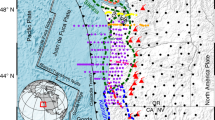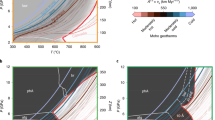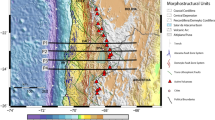Abstract
Oceanic lithosphere carries volatiles, notably water, into the mantle through subduction at convergent plate boundaries. This subducted water exercises control on the production of magma, earthquakes, formation of continental crust and mineral resources. Identifying different potential fluid sources (sediments, crust and mantle lithosphere) and tracing fluids from their release to the surface has proved challenging1. Atlantic subduction zones are a valuable endmember when studying this deep water cycle because hydration in Atlantic lithosphere, produced by slow spreading, is expected to be highly non-uniform2. Here, as part of a multi-disciplinary project in the Lesser Antilles volcanic arc3, we studied boron trace element and isotopic fingerprints of melt inclusions. These reveal that serpentine—that is, hydrated mantle rather than crust or sediments—is a dominant supplier of subducted water to the central arc. This serpentine is most likely to reside in a set of major fracture zones subducted beneath the central arc over approximately the past ten million years. The current dehydration of these fracture zones coincides with the current locations of the highest rates of earthquakes and prominent low shear velocities, whereas the preceding history of dehydration is consistent with the locations of higher volcanic productivity and thicker arc crust. These combined geochemical and geophysical data indicate that the structure and hydration of the subducted plate are directly connected to the evolution of the arc and its associated seismic and volcanic hazards.
This is a preview of subscription content, access via your institution
Access options
Access Nature and 54 other Nature Portfolio journals
Get Nature+, our best-value online-access subscription
$29.99 / 30 days
cancel any time
Subscribe to this journal
Receive 51 print issues and online access
$199.00 per year
only $3.90 per issue
Buy this article
- Purchase on Springer Link
- Instant access to full article PDF
Prices may be subject to local taxes which are calculated during checkout




Similar content being viewed by others
Data availability
All geochemical data generated during this study are included in this published article (and its supplementary information files) and can be accessed in the EarthChem repository (https://doi.org/10.26022/IEDA/111527). Compiled geochemical data are freely available from the GEOROC database (http://georoc.mpch-mainz.gwdg.de/georoc/). Shear velocity model data can be accessed at https://doi.org/10.5258/SOTON/D1306. All broadband OBS data collected by the VoiLA project will become freely available through the IRIS Data Management Center via their data request tools, at the end of the project (April 2021).
Code availability
For plate-tectonic reconstructions we used the GPlates software, which is freely available at https://www.gplates.org/ with the plate model at https://www.earthbyte.org/global-plate-models.
Change history
12 August 2020
A Correction to this paper has been published: https://doi.org/10.1038/s41586-020-2582-4
References
Hacker, B. R. H2O subduction beyond arcs. Geochem. Geophys. Geosystems 9, Q03001 (2008).
Grevemeyer, I., Ranero, C. R. & Ivandic, M. Structure of oceanic crust and serpentinization at subduction trenches. Geosphere 14, 395–418 (2018).
Goes, S. et al. Project VoiLA: Volatile Recycling in the Lesser Antilles. Eos 100, https://doi.org/10.1029/2019EO117309 (2019).
Wadge, G. Comparison of volcanic production rates and subduction rates in the Lesser Antilles and Central America. Geology 12, 555–558 (1984).
Boynton, C. H., Westbrook, G. K., Bott, M. H. P. & Long, R. E. A seismic refraction investigation of crustal structure beneath the Lesser Antilles island arc. Geophys. J. R. Astron. Soc. 58, 371–393 (1979).
Macdonald, R., Hawkesworth, C. J. & Heath, E. The Lesser Antilles volcanic chain: a study in arc magmatism. Earth Sci. Rev. 49, 1–76 (2000).
Melekhova, E. et al. Lateral variation in crustal structure along the Lesser Antilles arc from petrology of crustal xenoliths and seismic receiver functions. Earth Planet. Sci. Lett. 516, 12–24 (2019).
Hayes, G. P., McNamara, D. E., Seidman, L. & Roger, J. Quantifying potential earthquake and tsunami hazard in the Lesser Antilles subduction zone of the Caribbean region. Geophys. J. Int. 196, 510–521 (2014).
van Keken, P. E., Hacker, B. R., Syracuse, E. M. & Abers, G. A. Subduction factory: 4. Depth-dependent flux of H2O from subducting slabs worldwide. J. Geophys. Res. Solid Earth 116, B01401 (2011).
Carpentier, M., Chauvel, C. & Mattielli, N. Pb–Nd isotopic constraints on sedimentary input into the Lesser Antilles arc system. Earth Planet. Sci. Lett. 272, 199–211 (2008).
Bouysse, P. & Westercamp, D. Subduction of Atlantic aseismic ridges and Late Cenozoic evolution of the Lesser Antilles island arc. Tectonophysics 175, 349–380 (1990).
Schlaphorst, D. et al. Water, oceanic fracture zones and the lubrication of subducting plate boundaries—insights from seismicity. Geophys. J. Int. 204, 1405–1420 (2016).
Müller, R. D. et al. A global plate model including lithospheric deformation along major rifts and orogens since the Triassic. Tectonics 38, 1884–1907 (2019).
Escartín, J. et al. Central role of detachment faults in accretion of slow-spreading oceanic lithosphere. Nature 455, 790–794 (2008).
Manea, V. C., Leeman, W. P., Gerya, T., Manea, M. & Zhu, G. Subduction of fracture zones controls mantle melting and geochemical signature above slabs. Nat. Commun. 5, 5095 (2014).
Bach, W. & Früh-Green, G. L. Alteration of the oceanic lithosphere and implications for seafloor processes. Elements 6, 173–178 (2010).
De Hoog, J. C. M. & Savov, I. P. in Boron Isotopes: The Fifth Element (eds Marschall, H. & Foster, G.) 217–247 (Springer, 2018).
Leeman, W. P., Tonarini, S. & Turner, S. Boron isotope variations in Tonga–Kermadec–New Zealand arc lavas: implications for the origin of subduction components and mantle influences. Geochem. Geophys. Geosyst. 18, 1126–1162 (2017).
Leeman, W. P. in Subduction: Top to Bottom (eds Bebout, G. E. et al.) 269–276 (AGU, 1996).
Tonarini, S., Leeman, W. P. & Leat, P. T. Subduction erosion of forearc mantle wedge implicated in the genesis of the South Sandwich Island (SSI) arc: evidence from boron isotope systematics. Earth Planet. Sci. Lett. 301, 275–284 (2011).
Marschall, H. R. in Boron Isotopes: The Fifth Element (eds Marschall, H. & Foster, G.) 189–215 (Springer, 2018).
Bezard, R. et al. Assimilation of sediments embedded in the oceanic arc crust: myth or reality? Earth Planet. Sci. Lett. 395, 51–60 (2014).
Plank, T. in Treatise on Geochemistry 2nd edn (eds Holland, H. D. & Turekian, K. K.) 607–629 (Elsevier, 2014).
Benton, L. D., Ryan, J. G. & Tera, F. Boron isotope systematics of slab fluids as inferred from a serpentine seamount, Mariana forearc. Earth Planet. Sci. Lett. 187, 273–282 (2001).
Kaliwoda, M. et al. Boron and boron isotope systematics in the peralkaline Ilímaussaq intrusion (South Greenland) and its granitic country rocks: a record of magmatic and hydrothermal processes. Lithos 125, 51–64 (2011).
Jones, R. E. et al. Temporal variations in the influence of the subducting slab on Central Andean arc magmas: evidence from boron isotope systematics. Earth Planet. Sci. Lett. 408, 390–401 (2014).
McCaig, A. M. et al. No significant boron in the hydrated mantle of most subducting slabs. Nat. Commun. 9, 4602–10 (2018).
Paulatto, M. et al. Dehydration of subducting slow-spread oceanic lithosphere in the Lesser Antilles. Nat. Commun. 8, 15980 (2017).
Vils, F., Tonarini, S., Kalt, A. & Seitz, H.-M. Boron, lithium and strontium isotopes as tracers of seawater–serpentinite interaction at Mid-Atlantic Ridge, ODP Leg 209. Earth Planet. Sci. Lett. 286, 414–425 (2009).
Bie, L. et al. Along-arc heterogeneity in local seismicity across the Lesser Antilles subduction zone from a dense ocean-bottom seismometer network. Seismol. Res. Lett. 91, 237–247 (2020).
Kirby, S., Engdahl, R. E. & Denlinger, R. in Subduction: Top to Bottom (eds Bebout, G. E. et al.) 195–214 (AGU, 1996).
Hammond, W. C. & Humphreys, E. D. Upper mantle seismic wave velocity: effects of realistic partial melt geometries. J. Geophys. Res. Solid Earth 105, 10975–10986 (2000).
Gurenko, A. A., Trumbull, R. B., Thomas, R. & Lindsay, J. M. A melt inclusion record of volatiles, trace elements and Li–B isotope variations in a single magma system from the Plat Pays volcanic complex, Dominica, Lesser Antilles. J. Petrol. 46, 2495–2526 (2005).
Bouvier, A.-S., Métrich, N. & Deloule, E. Light elements, volatiles, and stable isotopes in basaltic melt inclusions from Grenada, Lesser Antilles: inferences for magma genesis. Geochem. Geophys. Geosystems 11, Q09004 (2010).
Bouvier, A.-S., Manzini, M., Rose-Koga, E. F., Nichols, A. R. L. & Baumgartner, L. P. Tracing of Cl input into the sub-arc mantle through the combined analysis of B, O and Cl isotopes in melt inclusions. Earth Planet. Sci. Lett. 507, 30–39 (2019).
Humphreys, M. C. S., Kearns, S. L. & Blundy, J. D. SIMS investigation of electron-beam damage to hydrous, rhyolitic glasses: implications for melt inclusion analysis. Am. Mineral. 91, 667–679 (2006).
Boschi, C. et al. Serpentinization of mantle peridotites along an uplifted lithospheric section, Mid Atlantic Ridge at 11° N. Lithos 178, 3–23 (2013).
Boschi, C., Dini, A., Früh-Green, G. L. & Kelley, D. S. Isotopic and element exchange during serpentinization and metasomatism at the Atlantis Massif (MAR 30° N): insights from B and Sr isotope data. Geochim. Cosmochim. Acta 72, 1801–1823 (2008).
Spivack, A. J. & Edmond, J. M. Boron isotope exchange between seawater and the oceanic crust. Geochim. Cosmochim. Acta 51, 1033–1043 (1987).
Marschall, H. R. et al. The boron and lithium isotopic composition of mid-ocean ridge basalts and the mantle. Geochim. Cosmochim. Acta 207, 102–138 (2017).
Workman, R. K. & Hart, S. R. Major and trace element composition of the depleted MORB mantle (DMM). Earth Planet. Sci. Lett. 231, 53–72 (2005).
Collier, J. S. VoiLA—Volatile Recycling in the Lesser Antilles Arc: RRS James Cook Cruise Report JC133, 79, https://www.bodc.ac.uk/resources/inventories/cruise_inventory/reports/jc133.pdf (2015).
Collier, J. S. VOILA—Volatile Recycling in the Lesser Antilles Arc: RRS James Cook Cruise Report JC149, 161, https://www.bodc.ac.uk/resources/inventories/cruise_inventory/reports/jc149.pdf (2017).
Landisman, M., Dziewonski, A. & Satô, Y. Recent improvements in the analysis of surface wave observations. Geophys. J. Int. 17, 369–403 (1969).
Levshin, A. L. & Ritzwoller, M. H. in Monitoring the Comprehensive Nuclear-Test-Ban Treaty: Surface Waves (eds Levshin, A. L. & Ritzwoller, M. H.) 1531–1545 (Birkhäuser Basel, 2001).
Harmon, N. & Rychert, C. A. Joint inversion of teleseismic and ambient noise Rayleigh waves for phase velocity maps, an application to Iceland: noise-teleseismic phase velocity maps. J. Geophys. Res. Solid Earth 121, 5966–5987 (2016).
Forsyth, D. W. & Li, A. in Seismic Earth: Array Analysis of Broadband Seismograms (eds Levander, A. & Nolet, G.) 81–97 (AGU, 2005).
Yang, Y. & Forsyth, D. W. Regional tomographic inversion of the amplitude and phase of Rayleigh waves with 2-D sensitivity kernels. Geophys. J. Int. 166, 1148–1160 (2006).
Harmon, N. et al. Mapping geologic features onto subducted slabs. Geophys. J. Int. 219, 725–733 (2019).
Braszus, B. 3D Teleseismic Travel Time Tomography along the Lesser Antilles Subduction Zone. MSc thesis, Karlsruhe Institute of Technology (2019).
Perrin, A. et al. Reconciling mantle wedge thermal structure with arc lava thermobarometric determinations in oceanic subduction zones. Geochem. Geophys. Geosyst. 17, 4105–4127 (2016).
Hicks, S. P. et al. Evidence for an anomalously large cold mantle wedge corner of the Caribbean Plate in the Lesser Antilles subduction zone. In AGU Fall Meeting 2019 T23A-08 (AGU, 2019).
Halpaap, F. et al. Earthquakes track subduction fluids from slab source to mantle wedge sink. Sci. Adv. 5, eaav7369 (2019).
Van Avendonk, H. J. A., Holbrook, W. S., Lizarralde, D. & Denyer, P. Structure and serpentinization of the subducting Cocos plate offshore Nicaragua and Costa Rica. Geochem. Geophys. Geosystems 12, Q06009 (2011).
Sandwell, D. T., Müller, R. D., Smith, W. H. F., Garcia, E. & Francis, R. New global marine gravity model from CryoSat-2 and Jason-1 reveals buried tectonic structure. Science 346, 65–67 (2014).
Davy, R. G., Collier, J. S., Henstock, T. J. & the VoiLA consortium. Wide-angle seismic imaging of two modes of crustal accretion in mature Atlantic Ocean crust. J. Geophys. Res. Solid Earth https://doi.org/10.1029/2019JB019100 (2020).
Acknowledgements
We thank our project partners R. Robertson, J. Latchman, S. Tait and F. Krüger for support and discussion over the course of this project. We thank C. J. de Hoog for assistance with SIMS analysis at the EIMF, S. Kearns for help with EPMA analysis, the German Instrument Pool for Amphibian Seismology (DEPAS), hosted by the Alfred Wegener Institute Bremerhaven, for providing the ocean-bottom and temporary island seismometers, and the Scripps Institution of Oceanography (OBSIP) for providing additional ocean-bottom seismometers. This research was funded by the VoiLA NERC consortium grant (NE/K010824/1). SIMS analysis was funded by EIMF proposals IMF619/0517 and IMF653/0518.
Author information
Authors and Affiliations
Consortia
Contributions
All authors discussed the results and implications of the work and commented on the manuscript at all stages. G.F.C., C.G.M., J.D.B. and A.A.I carried out geochemical analysis and interpretation. G.F.C., S.G., C.G.M., J.D.B. and J.C. drafted the manuscript. N.H. and C.R. produced the shear-wave velocity model. B.M. made the dehydration model. L.B. and S.P.H. compiled local seismicity data. D.S. mapped b-values. R.W.A and J.C. produced the tectonic reconstruction and associated figures. C.G.M., S.G., J.D.B., J.C., A.R., N.H., C.R., J.P.D., T.J.H., J.v.H., J.J.W. and M.W. designed the original VoiLA experiment.
Corresponding author
Ethics declarations
Competing interests
The authors declare no competing interests.
Additional information
Peer review information Nature thanks William Leeman and Othmar Müntener for their contribution to the peer review of this work.
Publisher’s note Springer Nature remains neutral with regard to jurisdictional claims in published maps and institutional affiliations.
Extended data figures and tables
Extended Data Fig. 1 Modelled fracture zones.
a, Modelled fracture zones in the central Atlantic overlaid on an oceanic crust age grid from ref. 13. Coloured stars denote conjugate points associated with opening of the equatorial Atlantic at either end of the Vema (green stars) and Doldrums (yellow stars) fracture zones, and between the Demerara Rise and African continental margin (red stars). b, Modelled fracture zones overlaid on satellite free-air gravity55. Red ellipse marks the location of the proto-Caribbean/Atlantic boundary.
Extended Data Fig. 2 Modified plate reconstruction.
Snapshot of modified plate reconstruction at 50 Ma (ref. 13). Velocity vectors (coloured by plate) shown are relative to the mantle reference frame. The figure shows the four sources of dehydration from the subducted slab over the past 25 Myr considered here: (i) Marathon FZ; (ii) Mercurius FZ; (iii) proto-Caribbean/ equatorial Atlantic boundary and (iv) unnamed FZ formed during proto-Caribbean opening, labelled PC Fracture Zone. MAR, Mid-Atlantic Ridge.
Extended Data Fig. 3 Melt inclusion δ11B.
a–e, All values of melt inclusion δ11B measured in this study are shown versus indicators of fluid composition (a, b) and differentiation (c–e). No clear observable trends are shown between islands, indicating that these differences are largely controlled by the mantle source.
Extended Data Fig. 4 Excess dehydration.
The average rate of excess dehydration (above a uniform background), resulting from the subduction of fracture zones and the proto-Caribbean/Atlantic plate boundary, along the arc from 11° N to 18° N over the past 2 Myr (red solid curve) and 25 Myr (blue dotted curve), and below the forearc over the past 2 Myr (dashed yellow line). The pattern of relative distribution of dehydration is robust, constrained by the history of fracture-zone/plate-boundary subduction, but the absolute values of the dehydration rates should be treated with caution, as they depend strongly on the simple model assumptions of the level of hydration and relative strength of fore- and sub-arc dehydration. a, Best estimate; b, northern bound endmember; c, southern bound (see text for details).
Supplementary information
Supplementary Data
The file contains source data for Figs 2–4.
Rights and permissions
About this article
Cite this article
Cooper, G.F., Macpherson, C.G., Blundy, J.D. et al. Variable water input controls evolution of the Lesser Antilles volcanic arc. Nature 582, 525–529 (2020). https://doi.org/10.1038/s41586-020-2407-5
Received:
Accepted:
Published:
Issue Date:
DOI: https://doi.org/10.1038/s41586-020-2407-5
This article is cited by
-
Reverse metasomatism of subduction zone fluids
Science China Earth Sciences (2024)
-
Deconstructing plate tectonic reconstructions
Nature Reviews Earth & Environment (2023)
-
Deep Earth bound by water
Nature Geoscience (2022)
-
Boron isotopes in boninites document rapid changes in slab inputs during subduction initiation
Nature Communications (2022)
-
A new analytical mode and application of the laser ablation inductively coupled plasma mass spectrometer in the earth sciences
Science China Earth Sciences (2022)
Comments
By submitting a comment you agree to abide by our Terms and Community Guidelines. If you find something abusive or that does not comply with our terms or guidelines please flag it as inappropriate.



